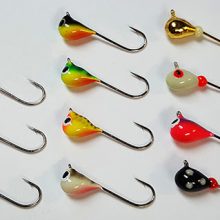This article may contain affiliate links. If you make a purchase after clicking on a link we may earn a small commission at no extra cost to you. As an Amazon Associate, I earn from qualifying purchases.
Walleye Jig Setup

A good walleye jig setup requires a rod, reel and line combo that can transmit the maximum amount of feedback back through the rod and into your hand.
A well balanced setup is key to adding the best action to your jigs whilst allowing you to detect even the faintest of strikes.
You need a rod that has a lot of sensitivity, the right reel to balance your rod and a low stretch line that can transmit as much feedback from the jig head back to the rod.
- Rod – spinning rod, 6 to 6’6″ in length, medium/light power rating with a fast action
- Reel – spinning reel size 2500
- Line – braid or fluorocarbon
Most walleye anglers will use a spinning rod and reel and either braid or fluorocarbon as the main line.
Walleye Jig Setup
1. Rod
Sensitivity is key when using a jig and a light, crisp rod that is well balanced is key to get the best action into your jigs.
When walleye jig fishing all day a heavy unbalanced rod will do nothing more than tire your arm out.
Look for a rod with a medium/light power rating and fast action and roughly 6 to 6’6″ in length.
Rod action describes where on the rod blank the bend in the rod will start to form once some pressure is applied to it.
A more moderate action will have the bend start in the middle of the rod whereas a fast action will start to bend in the top one third section towards the rod tip.
Most walleye rods will have a fast action as it gives you much better feedback, a snappier cast and will also allow you to set the hook quickly.
2. Reel
A high quality rod needs good reel and with reels it’s often a case of you pay for what you get.
A size 2500 spinning reel should be able to hold 120 yards of 10 lbs fluorocarbon or 120 yards of 20 lbs braid.
A heavy reel is definitely a poor choice as jigging demands that you are constantly moving the rod tip all day and if your reel is too heavy then you will have an unbalanced setup.
One of the top walleye fishing reels is the Shimano Stradic Ci4+ which is one incredibly smooth casting reel.
3. Line
Understanding that eliminating as much stretch from your line as possible is one of the best ways to figure out what makes a good walleye jigging setup.
The usual choice of walleye fishing line for jigging is either going to be braid or fluorocarbon
Monofilament comes with a natural stretch in it that is just not suitable for jigging with.
You need a line with low stretch as any action you put into the rod tip needs to be transmitted down through the line and into the jigs movement.
There is not much point in buying a light weight rod with a nice responsive tip only to loose the responsiveness because of your line stretching too much.
Also Read: Difference Between Perch and Walleye
Braid is a great main line but you must use a fluorocarbon leader as braid is very visible.
Fluorocarbon can be used as a main line, normally in the 8 to 10 lbs range.
Most walleye fishing tackle requires a low stretch line with the exception of crankbaits as larger treble hook lures work better with a slightly delayed strike.
4. Jigs
There is a massive range of walleye jigs available and the for a beginner it can seem overwhelming.
The better performing walleye jigs are usually round headed jigs with a wide gap on the hook.
There are lots of different shaped heads to choose from. Round heads, stand-ups, floating heads and swim heads to name but a few.
And a lot of plastic lures and baits that can be added to them.
